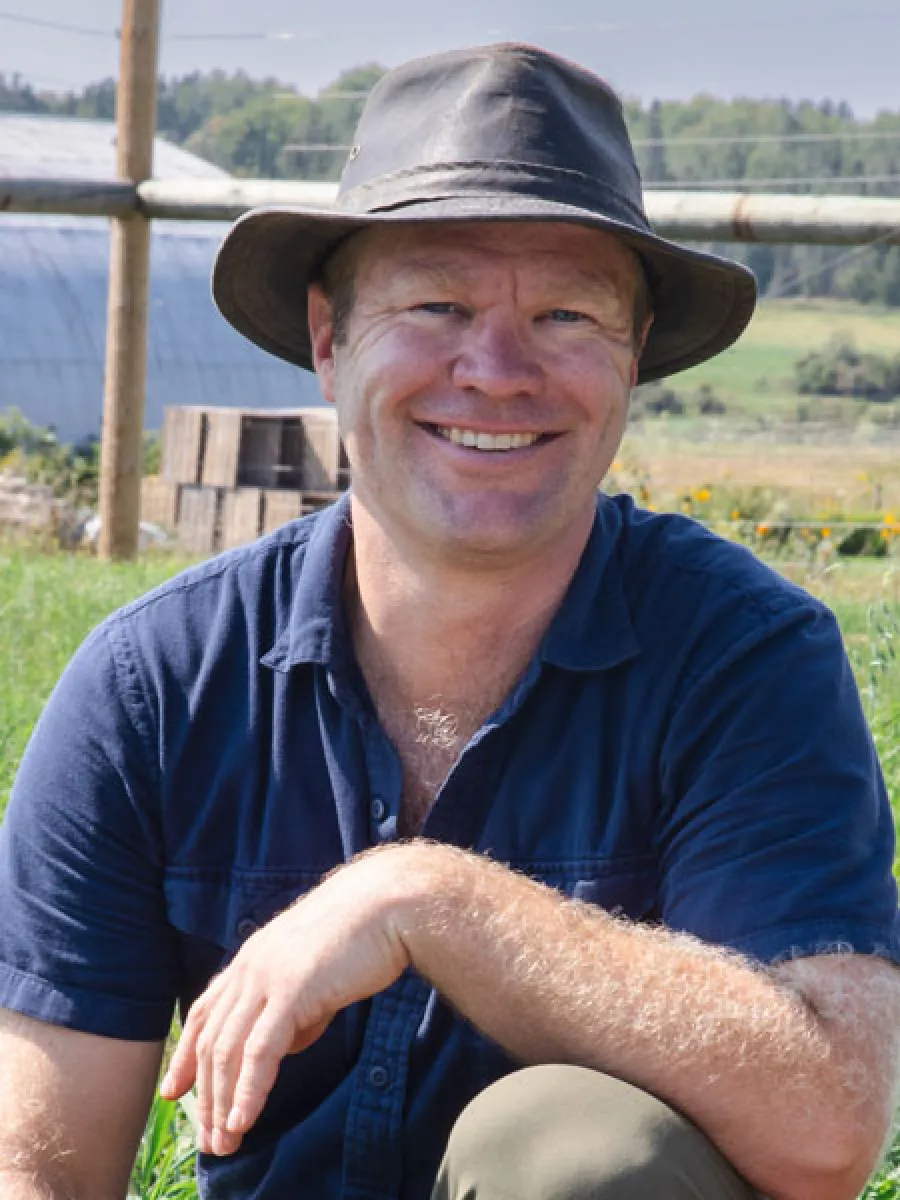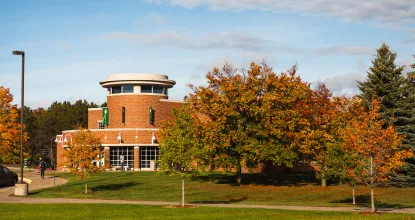In Memoriam, Dr. Fillmore C. F. Earney
November 5, 2025
Emeritus professor Dr. Fillmore C. F. Earney, age 94, passed away on Nov. 5, 2025. From 1966 to 1996 Dr. Earney was a Professor of Geography at NMU. He published and lectured about the geography of mining and mineral resources. His wife, Winnie Jo Earney, taught courses in business communication at NMU from 1966-1973. After Dr. Earney retired, the couple settled in Oregon until relocating to Florida.
In 1991 Dr. Earney chartered NMU’s Eta Chi chapter of Gamma Theta Upsilon International Geographical Honor Society. He kept in touch with the department and appreciated updates on Eta Chi’s activities and multiple Honor Chapter awards.
Dr. Earney’s influential teaching inspired Dr. Frederick Nelson ’73 to establish the Fillmore C. F. Earney Endowment in 2003. In recent years, recipients of a scholarship from the endowment could select a piece of jewelry that Dr. Earney had handcrafted. The students wore these special mementos while presenting their research or walking at Commencement. Dr. Earney’s contributions to geography education at Northern live on.
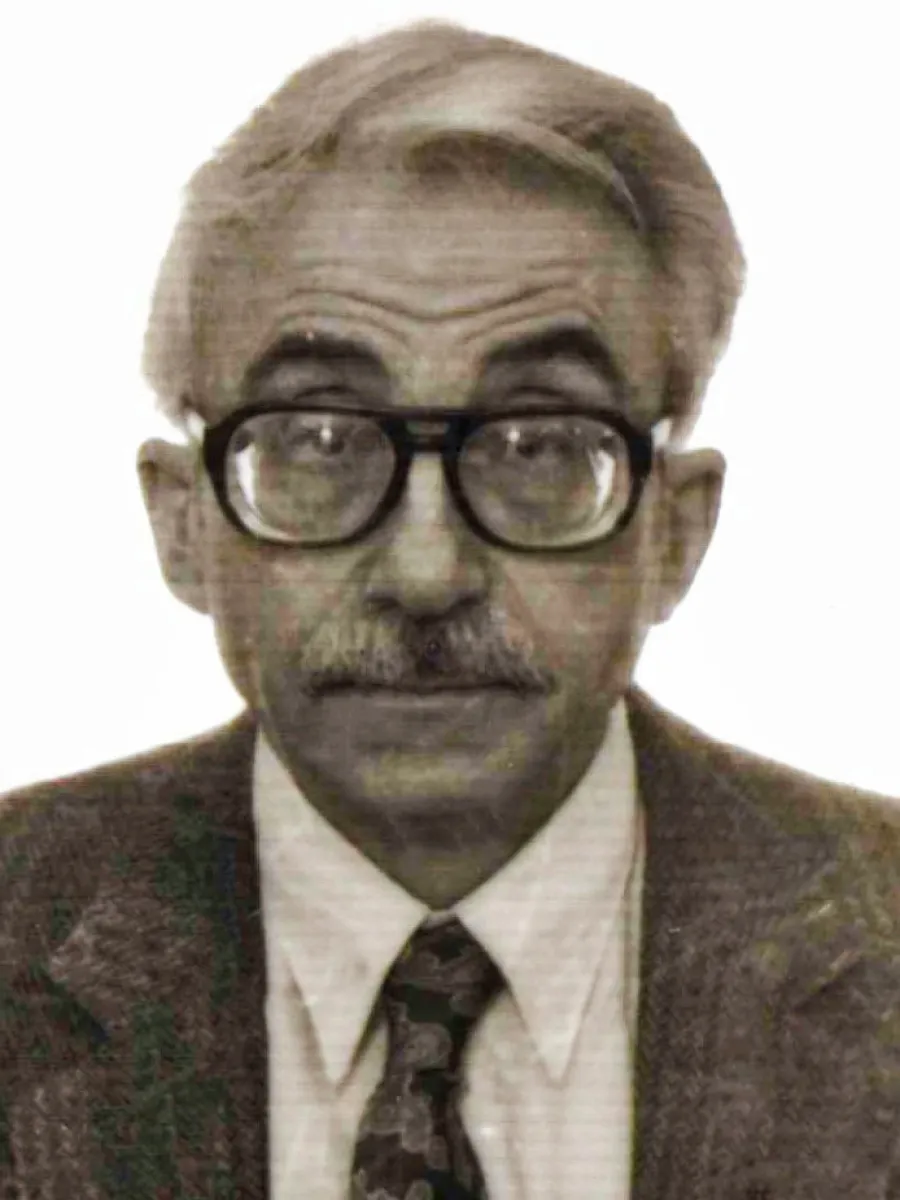
Adebiyi receives the 2025-2026 Faculty Emerging Leadership Award
October 28, 2025
Dr. Jelili Adebiyi is the recipient of the 2025-2026 NMU Faculty Emerging Leadership Award. The award "recognizes and honors junior faculty who since coming to the university have demonstrated exceptional leadership attributes on campus and the broader community."
Adebiyi joins Dr. Adam Naito and Dr. Ryan Stock as one of three EEGS faculty members that have received the Faculty Emerging Leadership award.

Ziegler receives the 2025-2026 Excellence in Part-Time Teaching Award
October 28, 2025
Mr. Richard Ziegler is the recipient of the 2025-2026 NMU Excellence in Part-Time Teaching Award. The award recognizes "teaching excellence by Northern Michigan University’s part-time faculty."
Ziegler regularly teaches courses such as GC 225 - Introduction to Maps, GC 255 - Physical Geology, and GC 376 - Field Geology.

Frank interns with the Student Conservation Association at Kenai Fjords National Park
October 28, 2025
Delany Frank (BS Environmental Science, GIS Certificate) interned at the Kenai Fjords National Park for three months in the summer of 2025 as a Student Conservation Association Invasive Plant Intern. Delaney worked with the park plant ecologist and two Youth Conservation Corps members to collect geospatial data on the presence of invasive plants using ArcGIS Field Maps and treated them through manual or chemical means. Delaney also had the opportunity to work on a Bureau of Land Management Seeds of Success project at Yukon-Charley Rivers National Preserve where she collected native plant seeds, gathered and classified soil samples, pressed plants, and created geospatial datasets representing the collection sites. In addition, Delany hiked the Harding Icefield Trail to map and better delineate a path that would ensure visitor safety while minimizing the risk of visitors would create social trails that could damage alpine vegetation and impact revegetation efforts. Lastly, Delaney spent several days with the park wildlife biologist to take bird count surveys, install acoustic monitors on the Chiswell Islands, and participate in a COASST survey.
Delany learned that her classroom and lab experience here at Northern were relevant and valuable throughout her internship experience. Delany notes that, “My biggest takeaway from this experience was to approach every opportunity unafraid and willing to learn. By remaining calm and open to everything throughout my internship, I was able to learn so much about conservation, conduct fieldwork safely in the backcountry, and contribute to efforts to preserve the beauty of Alaska. My advice for my peers is to get as involved as possible on campus and to take advantage of all opportunities at NMU.”
At Northern, Delany works as the SHINE Sustainability Audit Intern, the EcoReps Social Media Intern, and as a teaching assistant for developmental math. Additionally, Delany serves as a member of the Student Leadership Fellowship Program, Gamma Theta Upsilon, the NMU Fly Fishing Club, and the Michigan Wetlands Association.
We wish Delany the best as she completes her studies at Northern.
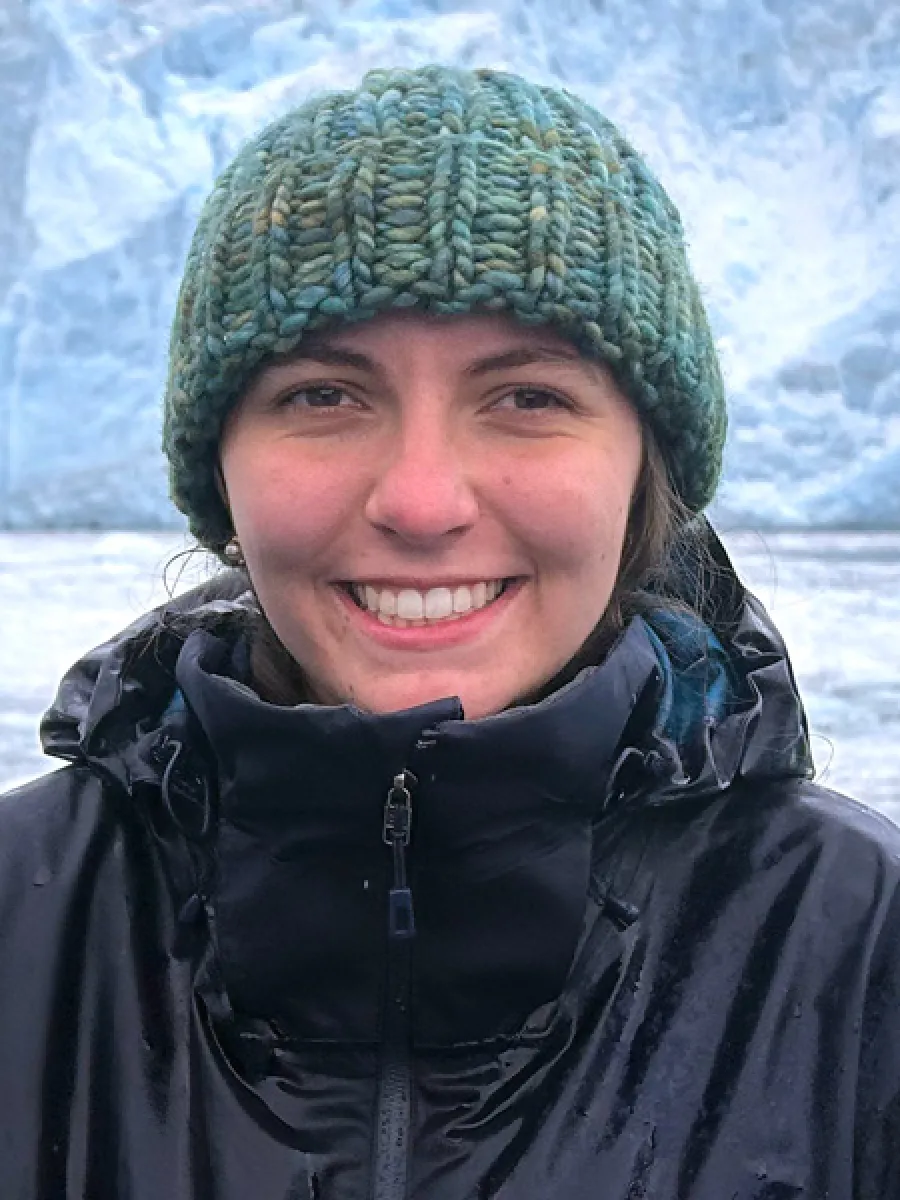
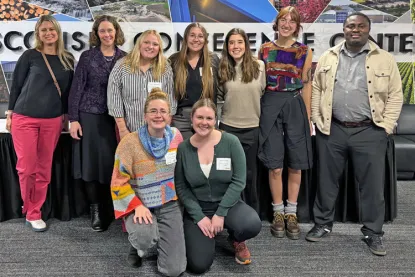
EEGS students and faculty attend the West Lakes American Association of Geographers conference
October 27, 2025
The EEGS Department brought students to the 2025 Meeting of the West Lakes Division of the American Association of Geographers held on October 23-25. The University of Wisconsin-Milwaukee hosted this year’s event. Gifts made by generous alumni and friends of EEGS support student participation at conferences like this one. EEGS undergraduates were inspired by the diversity of research that was presented. Students Avery Case, Cali Godlewski, Miki Rogers, Quinn Hilla, Lola Rigano, Lily Riehl, and Emma Teske attended and presented research ranging from carbon neutrality and sustainable farming, to waste auditing and wildfire vulnerability. Faculty members Dr. Weronika Kusek and Dr. Jelili Adebiyi, as well as Interim Dean of the College of Graduate Studies & Research and former EEGS Department Head Dr. Susy Ziegler also attended.
Please visit the West Lakes AAG 2025 feature news article to learn more.
Dedenbach presents at national meeting of the Society of American Foresters
October 27, 2025
Master of Science in Sustainability graduate student Ezra Dedenbach traveled with Dr. Sarah Mittlefehldt to present at the national meeting of the Society of American Foresters in Hartford, Connecticut from October 23-26. Ezra presented research related to the Northern Woodshed Project, an initiative funded through NMU’s SISU Institute that examines the feasibility of NMU potentially transitioning away from natural gas to using woodchips at the Ripley Heating Plant. The Northern Woodshed Project is an applied research collaboration between the Department of Earth, Environmental & Geographical Sciences, the Center for Native American Studies, the Department of Biology, and NMU Facilities.
Ezra received the Fillmore C. F. Earney Scholarship to support his graduate studies. As part of that recognition, Dr. Earney, who taught in the department from 1966-1996, made Ezra a special bolo tie using local magnetite. Ezra received many compliments about both his outstanding presentation and his fabulous tie at this national conference.
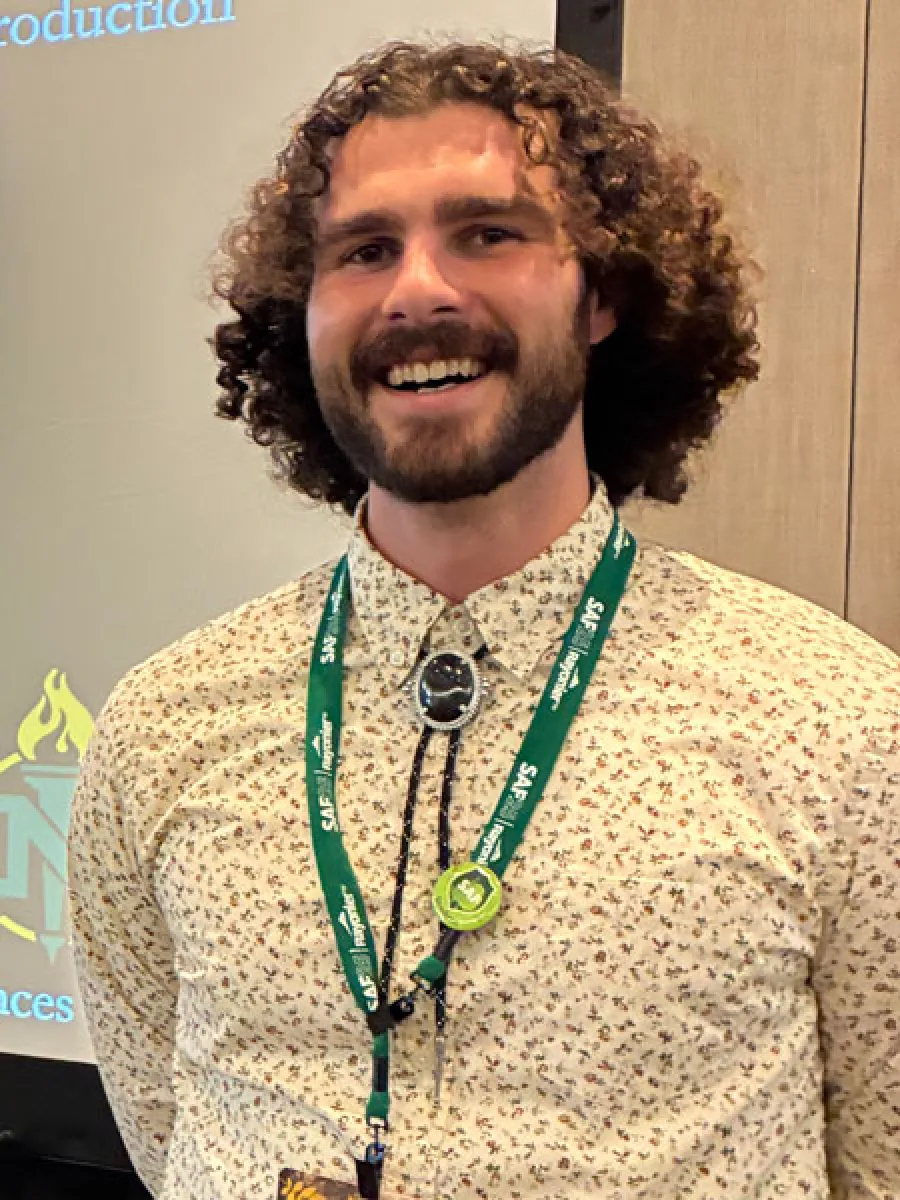
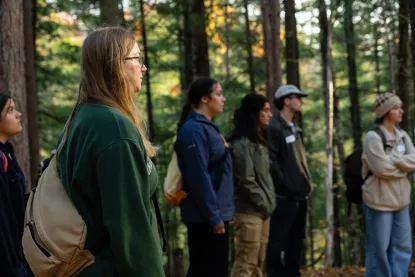
EEGS facilitates Working Forest Workshop with The Nature Conservancy
October 17, 2025
On October 17, EEGS partnered with colleagues at The Nature Conservancy to lead a Working Forest Workshop at the Slate River Forest in Baraga County. The purpose of the workshop was to learn about different forest management practices, including harvesting to produce old growth characteristics, coppicing of aspen stands for pulp markets, traditional hardwood cuts for saw timber, managing forests for their carbon potential, “land back” initiatives with the Keweenaw Bay Indian Community, and more. Workshop participants learned about different approaches to forest management as NMU considers woody biomass as an alternative to heat campus at part of the Northern Woodshed Project.
Back to top.
First EEGS Symposium on Sustainabili-TEA
October 15, 2025
On October 15, the department hosted its first EEGS Symposium. A room full of students and faculty enjoyed a cup of worker-owned, regeneratively-grown tea as they listened to Raj Vable, founder of Young Mountain Tea Company, discuss his journey from environmental studies student to transformer of industrial tea production. The Symposium helped to kick off EEGS new graduate program, the Master of Science in Sustainability, and is intended to help foster a culture of learning and collaboration within the department.
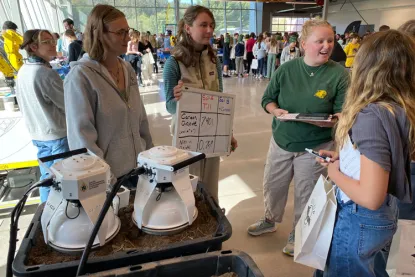
STEM & Career Fair for UP middle schoolers at the Jacobetti Complex.
October 10, 2025
On October 7, EEGS students Lola Rigano, Keira Halligan, Mary Jane Bauer, Cali Godlewski, Avery Thomas, Cora Pollen, Bridget Bentley, Ezra Dedenbach, and Erika Rivers volunteered with Dr. Matthew Van Grinsven, Dr. Angela Lafuente Garcia-Ubero, and Dr. Sarah Mittlefehldt to teach Upper Peninsula seventh graders about greenhouse gas monitoring and soil health. This was a part of a high-energy, hands-on celebration of science event known as Mind Trekkers, a collaboration with Michigan Technological University. The event was described as a “science fair meets carnival,” and showcased in-demand educational and career pathways for local youth.
Van Grinsven works with NMU students at local organic farms during sabbatical research
October 10, 2025
Dr. Matthew Van Grinsven (BS 06’ Earth Science) has been collaborating with Michigan State University Upper Peninsula Research and Extension Center (MSU-UPREC) and Full Plate Farm during his sabbatical appointment to provide organic farmers with cover crop management and reduced tillage practice guidance. This applied agronomy research project is focused on comparing common tillage and reduced tillage practices used by organic farmers, including the use of soil-tarping, to terminate cover crops to prepare soils for vegetable production. Since 2023, Dr. Van Grinsven has helped connect NMU students with employment, internship and volunteer opportunities through this research, where dozens of NMU students have gained physical, chemical and biological professional scientific skills training in the field and in the laboratory.
Between spring 2024 and fall 2025, Dr. Van Grinsven co-supervised three NMU student internships, one McNair Scholar, two Freshmen Fellows, one Undergraduate Research Fellow, one M.S. Integrated Bioscience, one M.S. Sustainability student, five directed studies & research courses, over a dozen volunteer field- and laboratory-technicians, three NMU student employees, and co-coordinated five MSU-UPREC employees who are either current NMU students or were recent NMU graduates as a part of this research project. Moreover, this work has connected numerous Departments across NMU’s campus where Dr. Van Grinsven collaborated with Dr. Philip Yangyuoru (NMU Chemistry), and worked directly with NMU students from the Earth, Environmental & Geographical Sciences, Chemistry, and Biology Departments.
To leverage upon the opportunity to conduct research during Dr. Van Grinsven’s sabbatical appointment, he collaborated with co-principal investigators Dr. James DeDecker (MSU-UPREC) and Dr. Laura Brosius (Full Plate Farm) to secure over $85,000 of funding to support this on-farm research, including grant awards from Organic Valley, MSU’s Doug & Maria Bayer New Initiative Fund for Sustainable Agriculture, and an NMU Faculty Research Grant. This funding support directly contributed to the numerous paid and volunteer student research opportunities that Dr. Van Grinsven helped facilitate since May of 2024. To date, Dr. Van Grinsven, NMU students and MSU-UPREC staff have delivered over a dozen presentations at professional meetings, to local and regional interest groups, and worked directly with farmers to share major outcomes, recommendations and guidance.
The scheduled on-farm activities are ongoing and will conclude during fall 2025, where Dr. Van Grinsven, NMU students and collaborators will work together to deliver professional presentations and prepare a series of technical reports and scientific publications summarizing major outcomes during 2025 and 2026. Ultimately, this collaborative team of researchers will share major findings focused on soil health & fertility, weed pressure, soil moisture management, greenhouse gas emissions, and crop productivity from this multi-year and multi-farm research project with farmers, technical-resource specialists and academic researchers to provide practical guidance for organic farmers to better manage their vegetable production systems.
